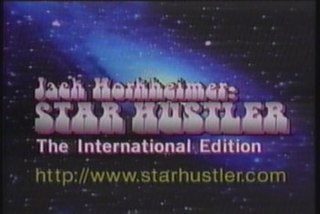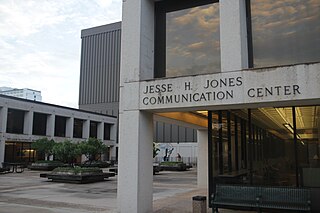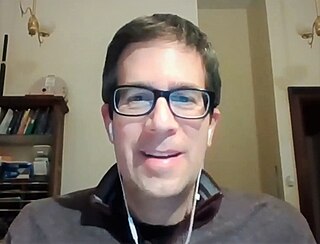
Sir Patrick Alfred Caldwell-Moore was an English amateur astronomer who attained prominence in that field as a writer, researcher, radio commentator and television presenter.

The Robert C. Byrd Green Bank Telescope (GBT) in Green Bank, West Virginia, US is the world's largest fully steerable radio telescope, surpassing the Effelsberg 100-m Radio Telescope in Germany. The Green Bank site was part of the National Radio Astronomy Observatory (NRAO) until September 30, 2016. Since October 1, 2016, the telescope has been operated by the independent Green Bank Observatory. The telescope's name honors the late Senator Robert C. Byrd who represented West Virginia and who pushed the funding of the telescope through Congress.

McDonald Observatory is an astronomical observatory located near unincorporated community of Fort Davis in Jeff Davis County, Texas, United States. The facility is located on Mount Locke in the Davis Mountains of West Texas, with additional facilities on Mount Fowlkes, approximately 1.3 kilometers (0.81 mi) to the northeast. The observatory is part of The University of Texas at Austin. It is an organized research unit of the College of Natural Sciences.
The Texas Star Party (TSP) is a large annual star party in the United States.

WRTI is a non-commercial, listener-supported radio station in Philadelphia, Pennsylvania. It is a service of Temple University, with the university's board of trustees holding the station's license. The studios are on Cecil B. Moore Avenue in Philadelphia. WRTI plays classical music from 6 a.m. to 6 p.m. and jazz all night. It broadcasts using HD Radio technology, using its digital subchannel to reverse this schedule. On WRTI-HD2, jazz is heard by day, classical music at night. News updates are provided by National Public Radio. The station holds periodic fundraisers on the air and on line.

Earth & Sky was a daily radio series that presented information about science and nature. It began broadcasting in 1991 and ceased operations in 2013. EarthSky is the ongoing website, serving 21 million users in 2019, according to Google Analytics.
Deborah Byrd is an American science journalist. She is editor-in-chief of EarthSky, which presents science news and night sky information. The website served more than 21 million users in 2019, according to Google Analytics.

KUT is a listener and community supported public radio station based in Austin, Texas. KUT is owned and operated by the University of Texas at Austin. It is the National Public Radio member station for central Texas. Its studio operations are located on campus at the Dealey Center for New Media. KUT is one of three radio outlets based on UT campus alongside student-run KVRX 91.7 FM and KUTX 98.9 FM.

Harlan James Smith was an American astronomer. He served as director of the University of Texas McDonald Observatory from 1963 to 1989, where, among other accomplishments, he initiated the construction of the Harlan J. Smith Telescope, a 2.7-meter (107-inch) reflector bearing his name.

Star Gazers is a short astronomy show on American public television previously hosted by Jack Horkheimer, executive director of the Miami Space Transit Planetarium. After his death in 2010, a series of guest astronomers hosted until 2011, when Dean Regas, James Albury, and Marlene Hidalgo became permanent co-hosts. In 2019, Dean Regas and James Albury stepped down from the program and were replaced by Trace Dominguez. On the weekly program, the host informs the viewer of significant astronomical events for the upcoming week, including key constellations, stars and planets, lunar eclipses and conjunctions, as well as historical and scientific information about these events.

Las Cumbres Observatory (LCO) is a network of astronomical observatories run by a non-profit private operating foundation directed by the technologist Wayne Rosing. Its offices are in Goleta, California. The telescopes are located at both northern and southern hemisphere sites distributed in longitude around the Earth. For some astronomical objects, the longitudinal spacing of telescopes allows continuous observations over 24 hours or longer. The operating network currently consists of two 2 meter telescopes, nine 1 meter telescopes, and seven 40 cm telescopes, placed at six astronomical observatories. The network operates as a single, integrated, observing facility, using a software scheduler that continuously optimizes the planned observing schedule of each individual telescope.

Third-party evidence for Apollo Moon landings is evidence, or analysis of evidence, about the Moon landings that does not come from either NASA or the U.S. government, or the Apollo Moon landing hoax theorists. This evidence provides independent confirmation of NASA's account of the six Apollo program Moon missions flown between 1969 and 1972.

The Moody College of Communication is the communication college at The University of Texas at Austin. The college is home to top-ranked programs in advertising and public relations, communication studies, communication and leadership, speech, language and hearing sciences, journalism, and radio-television-film. The Moody College is nationally recognized for its faculty members, research and student media. It offers seven undergraduate degrees, including those in Journalism, Advertising, and Radio-Television-Film, and 17 graduate programs. The Moody College of Communication operates out of the Jesse H. Jones Communication Complex and the Dealey Center for New Media, which opened in November 2012.
Jon Lomberg is an American space artist and science journalist. He was Carl Sagan's principal artistic collaborator for more than twenty years on many projects from 1972 through 1996. In 1998, the International Astronomical Union officially named an asteroid in recognition of his achievements in science communication. He was NASA's Design Director for the Golden Record on the Voyager spacecraft; the cover he designed is expected to last at least a billion years.

The Fairbanks Museum & Planetarium is a combination natural science museum, history museum, and planetarium located in St. Johnsbury, Vermont. It was founded in 1890 by businessman, politician, naturalist, and collector Franklin Fairbanks. The museum and its buildings are on the U.S. National Register of Historic Places.

Robert Berman, known as Bob Berman, is an American astronomer, author, and science popularizer. He runs Overlook Observatory in Woodstock, New York, USA. He was an adjunct professor of astronomy at New York’s Marymount College located in Westchester County, from 1996 to 2000 and has appeared on CBS This Morning, the Today Show, and the Late Show with David Letterman.
The SFA Observatory (SFA) is an astronomical observatory located 17 km (11 mi) north of Nacogdoches, Texas (USA). The observatory is owned and operated by Stephen F. Austin State University (SFASU), and opened in 1976. It is used for undergraduate instruction and for graduate-level research.
SkyWeek was a weekly astronomy television program created by Sky & Telescope magazine. The show was hosted by Tony Flanders, associate editor of Sky & Telescope magazine. Each episode of the program was released in one, three, and five-minute formats; and, the show's content and format were similar to that of another weekly astronomy program called Star Gazers. SkyWeek was carried by many PBS affiliates.

Amanda Elaine Bauer is an American professional astronomer and science communicator. She is the Deputy Director and Head of Science and Education at Yerkes Observatory in Williams Bay, Wisconsin. She was previously based in Tucson, Arizona, working as Head of Education and Public Outreach at the Large Synoptic Survey Telescope. From 2013 to 2016 she was a Research Astronomer at the Australian Astronomical Observatory (AAO). Her principal field of research concerns how galaxies form, how they create new stars, and particularly why they suddenly stop creating new stars.

Dean Regas is an American astronomer, public speaker, author, and television host. He is most widely known as the cohost of the syndicated television show Star Gazers, which airs daily on more than 100 PBS stations around the world. He was the Outreach Astronomer for the Cincinnati Observatory from 2000 to 2023 where he specialized in astronomy education and public speaking. Regas is the author of three books Facts From Space!, 100 Things to See in the Night Sky, and 100 Things to See in the Southern Night Sky.















